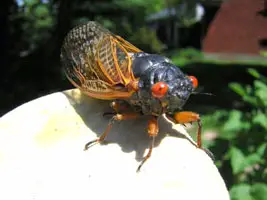Cicadas: They’re Baaaaaack!

If you’re visiting Chicago for the next few weeks, you won’t be alone. The cicadas are here! Yay- These insects may be ugly and noisy, but considering the periodical bugs only emerge once every 17 years, you can understand why their appearance is a big deal to many.Cicadas spend 17 years underground, feeding on tree roots. When the temperature and time are right, the immature insects will emerge from tunnels they have been digging toward the surface. Before dawn, these nymphs (the larval form of some insects) will climb trees, plants, and even road signs to find a place to complete their metamorphosis. Their skin will then split, and adult cicadas emerge an hour later, leaving behind their former shell. The bodies will still be white and soft though and will take about two hours to harden and darken. When daylight strikes, the adults continue their way up into the trees, where many of them are eaten by birds.
Three days from now, the males will begin singing their unique (and loud) song from morning until dusk. At 104 to 106 decibels, cicadas are louder than a motorcycle. As if that weren’t enough, areas with lots of trees can get as many as 1.5 million cicadas per acre. To give you an idea of just how many there can be, some folks have had to use snow shovels to clear the bugs off their sidewalks.
The loud “song” helps the males attract females, and although the males will mate several times (females mate just once), they will die shortly thereafter. The females will go on to lay 10 to 20 eggs at a time in twigs, each laying 400 to 600 eggs in total. One month later, the females die, and a month after that, nymphs will emerge from the eggs and fall to the ground. They’ll begin eating grass roots, and by the time winter comes, they’ll be 10 to 12 inches underground, munching on tree roots for another 17 years.
While cicadas may damage new plants and trees and are an annoyance to the ears, they’re otherwise harmless. They don’t bite, don’t carry diseases, and won’t hurt mature plantlife. The only harm they may cause pets is if Spot decides to eat too many, causing him an upset stomach. Most of the urban area of Chicago won’t have much to worry about (except for older parks like North Park, Jackson Park, and Humboldt Park), but if you’re going to be anywhere in the outlying suburban area, plan on running into these rare guests. And watch your step! Because cicadas’ survival relies on their vast numbers and mass emergence, these bugs never developed an active defense strategy, so they may not fly away if you’re about to step on them.
Photo credit: Greg_Smith
Tags: chicago, cicadas, gardening, humboldt-park, jackson-park, north-parkRelated Stories
POSTED IN: Uncategorized
4 opinions for Cicadas: They’re Baaaaaack!
Mary Jo
May 23, 2007 at 8:46 am
I experienced the Cicada Choir a couple years ago in Washington DC. I had been warned that they were pretty noisy, and all over the place, but still — when I finally there and saw/heard them, I was shocked. They were EVERYWHERE! And so loud! Who would have though that such a little creature could make so much noise.
Leora Zellman
May 25, 2007 at 9:49 am
I just moved to Chicago in late August so I didn’t really experience any Cicadas last year but I’m really nervous about it! We came to visit once and they were so loud and gross looking!
Lynn
May 31, 2007 at 2:54 am
That is so interesting! Are they all over the US, or are they mostly in the midwest and the northeast?
Matt B
May 31, 2007 at 9:11 am
There are many different species of cicadas, and as far as I know, they can be found everywhere. However, there are seven special species–four with 13-year cycles and three with 17-year cycles. These periodical cicadas are only found in the eastern half of the U.S.
Have an opinion? Leave a comment: